
Kuqa Konaklamanızı Bulun
En yeni fiyatları ve müsaitlik durumunu kontrol etmek için seyahat tarihlerinizi girin
Daha fazlasını görüntülemek için yukarı kaydırın
Filtrele:
Otel yıldız puanı
≤2345
Popüler Filtreler
Muhteşem 4,5+Harika 4,0+Çok İyi 3,5+İyi 3,0+Sizin için 212 adet Kuqa oteli bulduk
En yeni fiyatları görmek için seyahat tarihlerinizi seçin.
En Popüler
En Düşük Fiyat
Şehir Merkezine En Yakın
En İyi Yorum Alan

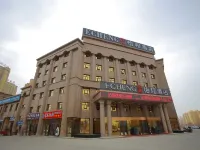
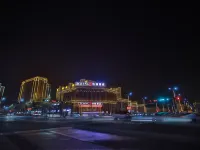
Otel Kuqa bölgesine yakın
KKellyLing 凌淑飛 2023.10.15
Excellent hotel, great professional staff, and very good location. Location is very central and restaurants everywhere downstairs. The hotel room is clean and very well appointed. Service is good, especially the front desk guy. He was very helpful and gave accurate advise. Free laundry service is a bonus and much appreciated. Breakfast is the usual fair, and can get crowded during peak hour. This hotel caters for tour buses so can get a bit busy and noisy in the evenings but rooms are really quite. One of the best hotels we have stayed in our trip and highly recommended. I hope they have more hotels everywhere in China.
Outstanding
1421 yorum
4.8/5
Gecelik
919 ₺
tutarından başlayan fiyatlar

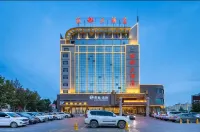

Otel Kuqa bölgesine yakın
ZZhangyuxiaowanzi。 2023.10.06
One of the most comfortable hotels in southern Xinjiang! ! !
I arrived a little late, but the service attitude of Xiao Zou and Xiaoyu at the front desk was super great! ! ! I really feel at home and warm.
The business standard room we booked was upgraded to an executive standard room for free.
Traveling as a family of four with two children, the two 1.5cm beds are super comfortable. The facilities in the room are relatively complete, and families traveling with children can close their eyes. There is a tea bar machine at the elevator entrance on each floor: milk tea, coffee, milk, and hot water are continuously supplied.
There are many types of breakfast, the service is also in place, all aspects are in order, the breakfast environment is very good, you can have breakfast leisurely.
The hotel parking lot is large and there is a free self-service car wash, which solved the problem of bug-contaminated car windshields along the way.
I will still choose your hotel next time I travel to Kuqa. The service is really good.
Outstanding
1373 yorum
4.8/5
Gecelik
1.306 ₺
tutarından başlayan fiyatlar



Otel Kuqa bölgesine yakın
AAnonymous User 2024.06.23
I accidentally used the Ctrip platform to book a room and came across this very nice hotel. The hotel has a large free parking lot. The security guard was also very enthusiastic and helped me carry my suitcase. The lady at the front desk saw that I was from out of town and took the initiative to upgrade my room type for free and also gave me a free breakfast. I was really touched [pleasant] [pleasant]. The hotel room It's about 30 square meters, and the two 1.5-inch beds are very spacious for sleeping. The bedding is also very good and close-fitting. For those of us traveling abroad, we travel about 500 kilometers a day. It's really refreshing to rest for a night. The room is open 24 hours a day. Constant temperature hot water, no need to adjust the hot and cold water back and forth, it is very comfortable to keep the same temperature after washing a lot of clothes. There is also an outdoor place to dry clothes, which is just right for the washed clothes to bask in the sun to kill bacteria.
The breakfast is also very rich, and you can eat Xinjiang’s seasonal fruits, which are really delicious! 👍Every hotel staff is very enthusiastic, making people feel very comfortable, the environment is also great, and the most important thing is clean and hygienic! Staying in this hotel at this price is really a great value! I will definitely come again next time I have the chance.
Excellent
223 yorum
4.5/5
Gecelik
469 ₺
tutarından başlayan fiyatlar

Bunları Tercih Edebilirsiniz
Kahvaltı Sunan Otellerİki Adet Tek Yataklı Odası Olan Oteller1 Çift Kişilik Yataklı OtellerYüzme Havuzlu OtellerÜcretsiz İptal İmkanı Sunan Oteller
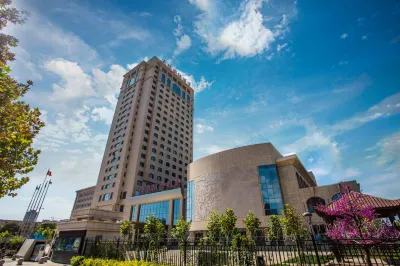


Otel Kuqa bölgesine yakın
GGuest User 2024.11.22
The hotel is located in a courtyard, parking is very convenient, the room and bed are very large. The hotel also provided breakfast, which was very considerate. The lady and handsome guy at the front desk checked in quickly, which was a very comfortable stay. Recommended!!!
Outstanding
538 yorum
4.6/5
Gecelik
890 ₺
tutarından başlayan fiyatlar



Otel Kuqa bölgesine yakın
AAnonymous User 2023.12.22
This is the most thoughtful hotel I have ever stayed in. When I entered the door, the waiter gave tea and coffee. I didn’t expect to have a free dinner. The most pleasant surprise was that I had breakfast this morning and dumplings. I originally thought I had to go to buy dumplings today. It can be said that the service is intimate and thoughtful. Worth five-star praise 👍🏻👍🏻👍🏻
Outstanding
658 yorum
4.7/5
Gecelik
735 ₺
tutarından başlayan fiyatlar



Otel Kuqa bölgesine yakın
GGuest User 2024.10.05
Booked a Jimu King Room:
1. The room is clean and spacious, with a smart toilet and smart voice control facilities, and the experience is good
2. Parking is convenient, and the underground parking lot is large
3. The service is enthusiastic, they will call in advance to confirm, enter the license plate, and provide water when leaving the hotel. The front desk brother is very handsome, and my husband can't help but praise the ceiling of appearance I have seen on this trip
4. The breakfast is also good, with a full range of categories. Although the number is not as many as that of star-rated hotels, it is also very delicious
5. There are many small restaurants around, which is convenient for eating. Because the floor is not high (3rd floor), there are occasional noises at night, but not loud
6. The disadvantage is that the price of advance booking may be more expensive than the temporary booking. You can check the latest price the day before, and rebook if it is expensive
Outstanding
996 yorum
4.8/5
Gecelik
842 ₺
tutarından başlayan fiyatlar

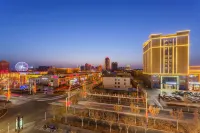

Otel Kuqa bölgesine yakın
GGuest User 2024.03.12
First of all, the hotel is located in the prime location of the city center, with all kinds of shopping, dining and entertainment facilities around it, convenient transportation, and convenient travel
The hotel's interior environment. The hotel's design style is modern and simple, with appropriate color matching, creating a warm and comfortable atmosphere. High-quality bedding allows you to have a perfect sleep during your journey. At the same time, the hotel has all kinds of facilities, including a gym and a restaurant
Here, you not only get a warm residence, but also a space to relax your body and mind
Excellent
384 yorum
4.5/5
Gecelik
682 ₺
tutarından başlayan fiyatlar



Otel Kuqa bölgesine yakın
Ssweet3508 2024.07.26
I drove 12 hours to Kuqa Kucha and stayed at Kucha Villa. Both the environment and facilities made me feel like I was in the ”daughter country”. The waiters were very warm in their reception and guidance. There is also a fat corgi in the hotel - Dafu, so cute🥰. You can ride shared electric scooters to various check-in points near the hotel, which is great! There are restaurants next to the hotel with Sichuan cuisine, which can completely satisfy your desire to eat and visit.
Outstanding
235 yorum
4.7/5
Gecelik
701 ₺
tutarından başlayan fiyatlar
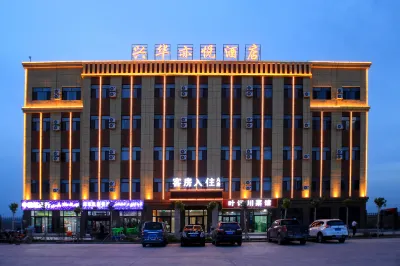


Otel Kuqa bölgesine yakın
WWeizhongqiangxiansheng 2024.08.06
房間整體乾淨整潔。忘記拍室內照片了。酒店不在庫車市中心,不過我們是自駕,所以圖的是交通方便,住在庫車市區邊上,這樣走獨庫公路也方便些。住的房間不含早餐,不過樓下就有好多餐廳,可以吃維族式早餐,也可以吃漢族式早餐,還是很方便的。
Outstanding
417 yorum
4.6/5
Gecelik
629 ₺
tutarından başlayan fiyatlar



Otel Kuqa bölgesine yakın
XXiaoxiaozi 2024.07.03
This is the second time I have booked Homeinn Hotel during my trip to Southern Xinjiang. The room is large and well-equipped, clean and sanitary, and all the staff are very welcoming. The breakfast was also very rich and delicious. In the afternoon, local red apricots were served, which were very sweet and delicious. Stayed for 2 nights. On the third day, we set off early on the Duku Highway and couldn't make time for breakfast. The hotel prepared snacks for us, which was very considerate. Beautiful Xinjiang, I will come again next time, and Homeinns Hotel will recommend it to friends who come to visit.
Outstanding
446 yorum
4.8/5
Gecelik
701 ₺
tutarından başlayan fiyatlar
Seyahatseverlerin beğendiği en iyi Kuqa otelleri seçkisi
Tümünü görüntüle
Geçtiğimiz ay en çok rezervasyon yapılan bu oteller arasından seçim yapın
No.1
4.3/5
229 yorumHUAKE YOUTH HOSTEL
Kuqa Otelleri
"Great value for money""Easy to get around"
Fiyatları görüntülemek için tarihleri seçinNo.2
4.8/5
771 yorumStarway Hotel (Kuqa Tianshan Middle Road)
Kuqa Otelleri
"Delicious breakfast""Friendly front desk staff"
Fiyatları görüntülemek için tarihleri seçinNo.3
4.7/5
860 yorumMarriott Holiday Hotel (Kuche Railway Station)
Kuqa Otelleri
"Delicious breakfast""Easy to get around"
Fiyatları görüntülemek için tarihleri seçinNo.4
4.7/5
1036 yorumYishang Hotel (Kuqa Jiankang Road Branch)
Kuqa Otelleri
"Delicious breakfast""Great value for money"
Fiyatları görüntülemek için tarihleri seçinNo.5
4.7/5
1172 yorumAll season hotel (Kuqa Tianshan Middle Road store)
Kuqa Otelleri
"Friendly front desk staff""Delicious breakfast"
Fiyatları görüntülemek için tarihleri seçinNo.6
4.2/5
91 yorumKuqa Hailin Hotel
Kuqa Otelleri
"Great service""Great rooms"
Fiyatları görüntülemek için tarihleri seçinNo.7
4.7/5
360 yorumKuqa Mengda Smart Business Hotel
Kuqa Otelleri
"Great rooms""Great amenities"
Fiyatları görüntülemek için tarihleri seçinNo.8
4.7/5
681 yorumKuqa Lanhai Smart Hotel (Municipal Government Branch)
Kuqa Otelleri
"Great rooms""Great amenities"
Fiyatları görüntülemek için tarihleri seçinNo.9
4.8/5
1396 yorumHome2 Suites By Hilton XinJiang Kuche
Kuqa Otelleri
"Great amenities""Delicious breakfast"
Fiyatları görüntülemek için tarihleri seçinNo.10
4.8/5
493 yorumAll Seasons Hotel (Kuqa East Lake Store)
Kuqa Otelleri
"Delicious breakfast""Great amenities"
Fiyatları görüntülemek için tarihleri seçinKuqa şehrinde leziz bir kahvaltıyla güne uyanın
Tümünü görüntüle
Bu şehirdeki en beğendiğimiz otellerden birinde lezzetli bir kahvaltıyla güne başlayın
Kuqa Chaoshi Wanhua International Hotel
Kuqa Otelleri
The Kuqa Chaoshi Wanhua International Hotel is one of the newest hotels in Kuqa, having opened in 2023. The hotel is conveniently located just 6km from Kuqa Railway Station and 13km from Kuqa Qiuci Airport. There is no shortage of things to see in the area, with the Kuqa Pedestrian Street, Kuqa Big Nang City and The Qiuci Wei and Jin Ancient Tombe Site Museum all nearby. When guests have some time on their hands they can make use of the onsite facilities. This Kuqa hotel provides parking on site. Our guests rate this hotel as one of the best hotels for cleanliness. This hotel is particularly popular with those traveling with families.
4.7/5
Outstanding1496 yorumGecelik başlangıç fiyatı:1.001 ₺
Vienna International Hotel (Kuqa Xingfu Road store)
Kuqa Otelleri
The Vienna International Hotel (Kuqa Xingfu Road store) provides a great place for travelers to relax after a busy day. The Vienna International Hotel (Kuqa Xingfu Road store) offers a pleasant stay in Kuqa for those traveling for business or leisure. The hotel is only 7km from Kuqa Railway Station and 16km from Kuqa Qiuci Airport, giving guests a number of convenient transportation options. With multiple attractions nearby including Qiuci Ecological Park, Old City of Kuche and Kuqa Pedestrian Street, guests will find plenty to keep themselves occupied. After a long day of sightseeing, guests can retire to the comfort of the hotel. This Kuqa hotel features parking on site. Germaphobes can rest easy - the level of cleanliness is highly rated at this hotel. This hotel is particularly popular with those traveling on business.
4.7/5
Outstanding1467 yorumGecelik başlangıç fiyatı:595 ₺
Ku Che Hotel
Kuqa Otelleri
The Ku Che Hotel is an ideal spot for travelers wanting to discover the city. Visitors to Kuqa will find that the Ku Che Hotel is a fantastic accommodation choice. With Kuqa Railway Station just 3km away and Kuqa Qiuci Airport only 14km away, transportation is very convenient. With multiple attractions nearby including Kuqa Pedestrian Street, Kuqa Datongcheng and Qiuci Cultural Square, guests will find plenty to keep themselves occupied. This hotel makes a great place to kick back and relax after a long day of sightseeing. This Kuqa hotel features parking on site. Germaphobes can rest easy - the level of cleanliness is highly rated at this hotel. This hotel is a popular accommodation for guests traveling for business.
4.6/5
Outstanding1480 yorumGecelik başlangıç fiyatı:1.340 ₺
Lavande Hotel Kuche Western Region Ledu
Kuqa Otelleri
The Lavande Hotel Kuche Western Region Ledu provides a great place for travelers to relax after a busy day. The Lavande Hotel Kuche Western Region Ledu offers a pleasant stay in Kuqa for those traveling for business or leisure. The hotel is only 7km from Kuqa Railway Station and 13km from Kuqa Qiuci Airport, giving guests a number of convenient transportation options. The nearby area boasts an abundance of attractions including The Qiuci Wei and Jin Ancient Tombe Site Museum, Kuqa Pedestrian Street and Qiuci Cultural Square. This hotel makes a great place to kick back and relax after a long day of sightseeing. For those driving themselves, parking is provided on site. This hotel is a popular accommodation for groups of friends traveling together.
4.4/5
Excellent1000 yorumGecelik başlangıç fiyatı:537 ₺
Duku Holiday Inn
Kuqa Otelleri
The Duku Holiday Inn is one of the newest hotels in Kuqa, having opened in 2022. The hotel is conveniently located just 7km from Kuqa Qiuci Airport and 13km from Kuqa Railway Station. This hotel is located near many of Kuqa's attractions including Keheidun Beacon Tower, Resitan Road and King Palace In Kuqa. In their spare time, guests can explore the hotel's surroundings. Guests of this Kuqa hotel can make use of the parking facilities. If cleanliness is important to you, this hotel makes an excellent choice, as our guests consider this to be one of the cleanest hotels in the city. This hotel is particularly popular with those traveling with friends.
4.6/5
Outstanding474 yorumGecelik başlangıç fiyatı:503 ₺
Ta Li Mu Hotel
Kuqa Otelleri
The Ta Li Mu Hotel provides a great place for travelers to relax after a busy day. The Ta Li Mu Hotel offers a pleasant stay in Kuqa for those traveling for business or leisure. With Kuqa Railway Station just 6km away and Kuqa Qiuci Airport only 16km away, transportation is very convenient. The nearby area boasts an abundance of attractions including Qiuci Ecological Park, Kuqa Pedestrian Street and The Qiuci Wei and Jin Ancient Tombe Site Museum. When guests have some time on their hands they can make use of the onsite facilities. Guests of this Kuqa hotel can make use of the parking facilities. Our guests consider this hotel to have excellent service. Perfect for those working on the move, this hotel caters to a large number of business guests.
4.4/5
Excellent458 yorumGecelik başlangıç fiyatı:445 ₺
Lan Du Hotel
Kuqa Otelleri
Opened in 2022, the Lan Du Hotel is a great accommodation choice in Kuqa. The hotel is only 6km from Kuqa Railway Station and 12km from Kuqa Qiuci Airport, giving guests a number of convenient transportation options. There is no shortage of things to see in the area, with the Tomb of Molana Arshidinhan, Qiuci Cultural Square and Kuqa Big Nang City all nearby. At the end of a busy day, travelers can unwind and relax in the hotel or go out and enjoy the city. Guests of this Kuqa hotel can make use of the parking facilities. If you demand a high level of service, our guests have indicated that this hotel has excellent standards. For guests traveling with groups of friends, this hotel is consistently one of the most popular choices.
4.4/5
Excellent391 yorumGecelik başlangıç fiyatı:571 ₺
4.7/5
Outstanding256 yorumGecelik başlangıç fiyatı:455 ₺
Kuqa Tiancheng Hotel
Kuqa Otelleri
Opened in 2022, the 库车天丞酒店(金桥太古里店) is a great accommodation choice in Kuqa. The hotel is conveniently located just 6km from Kuqa Railway Station and 13km from Kuqa Qiuci Airport. With multiple attractions nearby including Kuqa Pedestrian Street, The Qiuci Wei and Jin Ancient Tombe Site Museum and Kuqa Big Nang City, guests will find plenty to keep themselves occupied. When guests have some time on their hands they can make use of the onsite facilities. This Kuqa hotel features parking on site. According to our guests, this hotel provides a very high level of service. This hotel is particularly popular with those traveling on business.
4.7/5
Outstanding435 yorumGecelik başlangıç fiyatı:537 ₺
Wuzhou Hotel
Kuqa Otelleri
The Wuzhou Hotel provides a great place for travelers to relax after a busy day. The Wuzhou Hotel offers a pleasant stay in Kuqa for those traveling for business or leisure. Traveling to the hotel is easy with Kuqa Railway Station located approximately 5km away and Kuqa Qiuci Airport roughly 14km away. Seeing Kuqa's sights from this hotel is easy with Jinqiao Alley Night Market, Eye of Kuqa Ferris Wheel and The Qiuci Wei and Jin Ancient Tombe Site Museum all close by. When guests have some time on their hands they can make use of the onsite facilities. This Kuqa hotel features parking on site. Our guests consider this hotel to have excellent service. Perfect for those working on the move, this hotel caters to a large number of business guests.
4.7/5
Outstanding818 yorumGecelik başlangıç fiyatı:696 ₺
Sizin gibi seyahatseverlerin Kuqa otelleriyle ilgili düşüncelerine göz atın
Tümünü görüntüle
İdeal konaklama yerini bulmanıza yardımcı olması için gerçek seyahatseverlerin özgün puanlarını ve yorumlarını keşfedin
4.8/5
Outstanding
GGuest UserReally want to praise the service of this store. The front desk lady is super warm. The room we stayed in was downstairs or upstairs. The restaurant held the national wedding music. It was a bit noisy. I called the room and asked if we needed to change the room. We thought it was troublesome to forget it. The result was small. Sister can put the luggage in the original room~ Go to the quiet room to stay, we can lose our toss back and forth, really like 👍🏻
4.8/5
Outstanding
GGuest UserThe room was very clean, the boss was very good, and the water was blocked when I checked in. (The fifth picture) The boss changed the room in time. Because I booked two rooms, I chose not to change it. The boss contacted the person in time to repair it. The only downside was that there was a room with a smaller basin and shampoo. It is not very convenient. The water basin in the other room is of normal size, it is a very cost-effective place to stay, very close to Kuqa Wangfu and the old city, praise, recommended!
4.8/5
Outstanding
GGuest UserTraveling from Northern Xinjiang to Duku, we stayed at Kuqa Golden Sunshine Hotel. This was an unforgettable five-star experience! The staff were enthusiastic, and the check-in process was efficient and fast. They also introduced me to the hotel's free breakfast, dinner, free laundry, free Chinese medicine foot soaks, and free shoe shine services.
The room is spacious, bright, clean and tidy, with all the facilities in the room, including disposable towels and bath towels, which can meet my various needs.
The hotel's catering is even more amazing. The breakfast is rich in variety, ranging from Chinese porridge to Western bread and pastries, and the taste is excellent. The restaurant's elegant environment and attentive service make dining a pleasure.
In short, the service, facilities and environment are all top-notch. It is not only a place to stay, but also a home away from home where people can feel warm and comfortable. Highly recommended to everyone who pursues a high-quality accommodation experience!
4.7/5
Outstanding
GGuest User库车龟兹小巷蘭舍民宿
服务:服务到位满意
卫生:卫生干净
环境:环境优雅
适合我们出行的人居住,真诚推荐游客朋友到蘭舍民宿。
4.6/5
Outstanding
GGuest User#The sanitary room is very characteristic of the Uighur people in southern Xinjiang, the bathroom is clean and the bedding is clean and tidy. #Room facilities Uighur decoration style, very stylish small yard, hot water supply in the room, kettle, disposable supplies are also very complete. #The service landlord is a very friendly and talkative uncle, chatting is easy and humorous. #Parking and parking are very convenient, you can park at the entrance of the courtyard #WIFI network speed to take off #The bed is soft and comfortable
4.6/5
Outstanding
772The room was basically satisfactory. There were a lot of people at breakfast, but the first floor was full and a restaurant on the second floor was opened where you could have a meal. The quality of breakfast is acceptable, one egg per person and ramen. The toilet seat needs to be replaced in time, it doesn't cost much, it looks disgusting, and the size doesn't match.
4.5/5
Excellent
EemdethuongThis hotel can accept foreigners. It is around 1km from Kuqa railway station which is walkable. I arrived very early (6AM). I took forever for check-in because the reception had minimal experience with foreign guests and asked too many (repetitive) questions. She inspected the passport even more thoroughly than the police in Kuqa that I encountered. She asked about the stamps of other countries as well (not sure why and what it has got to do with the hotel check-in). I had a previous Chinese visa which I repetitively said it was old and pointed to the new one, but she kept coming back to it and asking for more info again and again. After almost 30 mins, I was able to come to the room, still the reception came knocking 2 more times for more questions. The second time I had to politely gave a sign that I wanted to sleep for a bit because I had sightseeing to do a couple hours later. I don’t know if this is protocol for Kuqa. So far the most ‘questioning’ hotel which I only expected to happen in Hotan. I negotitated to check in early because I would check out very early the next day (4.30AM) to board the train to Kashgar. It took a while to negotiate but it was possible in the end. Clealiness is so so, not the best but acceptable. It was not a memorable stay but the room will suffice your comfort. Just wish the check-in process would be faster and simpler. 100rmb deposit at check-in which will be refund at check-out.
4.5/5
Excellent
GGuest UserThe room is clean and tidy, the facilities are new, and the towels are compressed towels, which reduces the infection rate of reuse. The service is very friendly. Especially the proprietress, she is very warm and generous. Hotels in the surrounding areas have adjusted their prices due to the tourist boom, so they offer the same price for the whole day.
4.5/5
Excellent
GGuest UserThe service at the front desk of the hotel was warm and thoughtful, and all the questions raised were solved with care. The staff were also very kind, and they took the initiative to help me when they saw that I had a lot of luggage. This made me feel very warm. The overall environment was warm and quiet, and the room was clean and tidy. Moreover, the Kuqa Palace really has ethnic characteristics and is suitable for taking pictures. I had a lot of fun outing this time. I will choose your place next time I come to Kuqa to stay~
4.4/5
Excellent
GGuest UserParking is convenient. The hotel is clean, spacious and bright. It is very close to Kuqa Qiuci Alley and Kuqa Daheng City Scenic Area. The surrounding Jinqiao supermarket is large and has many kinds of things. It is very convenient overall. I will stay here again next time I come here.
Seyahatseverler Kuqa cazibe merkezleriyle ilgili neler söylüyor?
Kuqa şehrindeki görülmeye değer yerleri keşfedin ve daha rahat gezmek için yakında bir otel seçin
King Palace In Kuqa
MmackelThe Kuche Palace is a must-visit spot as the landmark of Kuche City. It contains the life story of the last prince, and you will learn that he was a very patriotic man who supported the Communist Party of China and national unity.
Kuqa Pedestrian Street
游游侠半仙Free travel by car, hotel near Kuqa Pedestrian Street, punching Kuqa Pedestrian Street, a little disappointed, no other city pedestrian street lively.
Resitan Road
游游侠半仙Travel freely in Kuqa and check in at Restan Road. Restan Road is one of the few old residential areas in Kuqa that still retains ethnic characteristics. The buildings here are colorful and full of local cultural atmosphere.
Duku Highway Endpoint Monument
柯柯少的诗和远方Very worth it, punching in is very filmed, full of shock
Scenic Area of Largedragon Pools
郭郭润龙浪迹天涯20230720 morning: 1. "Dalongchi" is located on the "Duku Highway". Duku Highway is the 217 National Road "Kuqa-Dushanzi" section, the length of 561 kilometers, is the traffic road of the north and south Xinjiang, the scenery along the way is beautiful, across the Gobi, hills, streams, wetlands, grasslands, snow-capped mountains, canyons and other landforms, known as the "most beautiful highway", It is a paradise for self-driving parties, the south is the desolate and rough Gobi mountain, and the north is the vibrant grassland valley. At least half of the highways are in areas above 2,000 meters above sea level, and the highest altitude is more than 3,400 meters. It is generally closed from early November to May and June of the next year due to weather. ① Address: Kuche City, Aksu District, Xinjiang Uygur Autonomous Region, to Dushanzi District, Karamay City. ② Transportation: No bus access. ③ peak season: no. ④ Time: 2-4 Days. 2. Duku Highway began in 1964 with the approval of the central project 07042 and 0603, in 1969 officially construction, to 1979 the whole line opened to traffic, due to the difficult project, natural conditions, the construction process of 168 PLA soldiers gave their lives. Duku Highway is a monument in the history of China's highway construction, and its significance is that: ① greatly improve transportation efficiency: shorten the original journey of more than 1,000 kilometers from the north and south Xinjiang by half, saving time, effort and money. ② Promote Xinjiang's economic development: If you want to build roads first, it is convenient for Xinjiang's cattle, sheep, fruits, resources and energy to integrate advantageous resources. ③ Strengthen territorial defense capabilities: Xinjiang is bordered by 8 countries, and its geographical location is important and its national defense is of great significance. ④ Promote north-south exchanges in Xinjiang: Xinjiang accounts for 1/6 of the country's territory, and the north and south Xinjiang are blocked by Tianshan, and most residents of the two Xinjiangs have never visited another area in their lifetime. ⑤ Accumulation of construction experience: 1950s coincided with the deterioration of China-Soviet relations. After losing assistance, China's infrastructure construction began from scratch. Overcoming various difficulties in construction, accumulated experience and became today's "Infrastructure Crazy" step by step. ⑥ makes self-driving tour possible. 3, the size of the dragon pool: one large and one small 2 alpine lakes, "small dragon pool" small pocket, "big dragon pool" more magnificent, the water area of 2 square kilometers, the water is beautiful blue and green, surrounded by mountains and forests, can be with the snow mountain in the distance. The scenic spot is a free open landscape. There is a parking platform on the roadside. You can enjoy the lake when you get off the bus. There are watermelon and fruit on the observation deck. There are many types of fruit. There are jackfruit dried, fig dried, and cucumber dried in the Central Plains area. If you want to go to the lake pier at the lower end of the road, you can pay for a boat tour of the lake. When Xuanyu Xitian in the Tang Dynasty, he passed by Dalongchi when he took the scriptures, which is recorded in his "Tales of the West Region of Datang".
Kuche Temple
大大奔哎哟喂With its unique architectural style, strong religious atmosphere, rich cultural connotation and important historical status, Kuqa Temple has become a cultural business card for Kuqa and the entire Xinjiang region. It attracts visitors and religious culture lovers from all over the world to visit, worship and study. Whether interested in architectural art or eager to gain insight into Islamic culture and Uighur traditions, Kuqa Grand Temple can give them a profound and memorable experience. Here, people can feel the blend and collision of ancient civilization and modern life, and appreciate the vastness and unique charm of Western culture.
Kuqa Big Nang City
JjeaniaKuche big naan is very famous, and it is indeed the best naan here in southern Xinjiang. The ticket to the big naan city is 20 yuan. There is not much to see inside, but the open-air singing and dancing performances are very sincere, and you can also take photos with the beautiful dancing girls.
Qiuci Ancient City
潇潇洒1哥This desert ancient city makes people curious, but also marvel at the aspirations of people at that time, not afraid of hardship, wisdom and sweat built, left to the future people is curiosity and admiration journey, desolate to feel the happiness of life now.
Kuqa Bazaar
TtravelerererThe Grand Bazaar in Kuche is not as lively and large as the International Grand Bazaar in Urumqi, but it is also quite large and has a very good environment. It has local characteristics.
Old City of Kuche
游游侠半仙Kuqa Old Town is a famous national historical and cultural city, and most of the residents are Uighurs. The ancient buildings in the city have absorbed the cultural elements and architectural styles of the Central Plains and Europe, and also integrated the traditional architecture, painting and singing and dancing art of the Western Region, which still retains the traditional pattern and historical style.
Kuqa ile İlgili Sık Sorulan Sorular
Popüler Kuqa otelleri hangileri?
Kuqa birçok popüler otel içeriyor. İster iş ister tatil seyahatleri için HUAKE YOUTH HOSTEL, Starway Hotel (Kuqa Tianshan Middle Road) ve Marriott Holiday Hotel (Kuche Railway Station) ideal birer otel seçimi.
Kuqa otelleri için ortalama fiyat ne kadar?
Kuqa otelleri için hafta içi ortalama fiyat 1.256 ₺, hafta sonu (Cuma-Cumartesi) ortalama fiyat ise 1.250 ₺.
Kuqa için hangi lüks oteller öneriliyor?
Kuqa, farklı stillere sahip birçok lüks otel içeriyor. Örneğin Kuqa Chaoshi Wanhua International Hotel ve Tianyuan International Hotel çok popüler.
Hangi Kuqa oteli kaliteli kahvaltılar sunuyor?
Kuqa Chaoshi Wanhua International Hotel,Tianyuan International Hotel ve Atour X Hotel Kuqaguizi Ancient City kaliteli kahvaltı sunuyor. Güne enfes bir kahvaltıyla başlayın!
Çocuklarla seyahat için hangi Kuqa otelleri öneriliyor?
Atour X Hotel Kuqaguizi Ancient City, jianglaihao ve Kuqa Chaoshi Wanhua International Hotel ailece seyahat etmeye çok uygun birer seçenek. Çocuklarınızla ve ailenizin diğer üyeleriyle seyahat etmenin tadını çıkarın!
Hangi Kuqa otellerinde fitness olanakları sunuluyor?
HUAKE YOUTH HOSTEL, Marriott Holiday Hotel (Kuche Railway Station) ve Starway Hotel (Kuqa Tianshan Middle Road) fitness olanakları sunuyor. Seyahat ederken de formda kalabilirsiniz!
Hangi Kuqa otelleri evcil hayvanlara izin veriyor?
Kuqa Mengda Smart Business Hotel, jianglaihao ve Kuche Buzhiguiyin Homestay evcil hayvanlara izin veriyor. Seyahatinizde evcil hayvanlarınızla birlikte konaklayın!
Hangi Kuqa otellerinde yüzme havuzu var?
Yicheng Hotel (Kuqa Tianshan Middle Road), Vienna International Hotel (Kuqa Xingfu Road store) ve Lavande Hotel Kuche Western Region Ledu yüzme havuzları içeren birer otel. Yüzme havuzunun keyfini çıkarmak için bu otellerden birinde kalabilirsiniz.
Hangi Kuqa oteli ücretsiz Wi-Fi bağlantısı sunuyor?
İster iş ister tatil için seyahat ediyor olun, internet bağlantısına sahip olmak her zaman önemlidir. HUAKE YOUTH HOSTEL, Starway Hotel (Kuqa Tianshan Middle Road) ve Marriott Holiday Hotel (Kuche Railway Station) ücretsiz Wi-Fi sunan popüler birer otel.
Hangi Kuqa otelleri havalimanı transfer hizmetleri sunuyor?
Kuqa aşina olduğunuz bir yer değil mi? HUAKE YOUTH HOSTEL, Starway Hotel (Kuqa Tianshan Middle Road) ve Marriott Holiday Hotel (Kuche Railway Station) havalimanı transfer hizmetleri sunuyor.
Hangi Kuqa otelleri denemeye değer spa deneyimleri sunuyor?
Seyahat etmekten yorgun mu düştünüz? HUAKE YOUTH HOSTEL, Starway Hotel (Kuqa Tianshan Middle Road) ve Marriott Holiday Hotel (Kuche Railway Station) yüksek puanlı spa hizmetleri sunuyor.
Hangi Kuqa otelleri çiftler için uygun?
Kuqa seyahatlerinde birçok çiftin konaklama tercihi Ku Che Hotel ve Tianyuan International Hotel.
Kuqa otel promosyonları neler?
Trip.com, kullanıcılarına yıl boyunca çeşitli promosyonlar ve indirimler sunuyor. Trip.com'da sunulan promosyonlar için promosyonlar sayfasına göz atabilirsiniz.
Yerel Seyahat Bilgileri
| En Yüksek Fiyat | 5.054 ₺ |
|---|---|
| En Düşük Fiyat | 232 ₺ |
| Yorum Sayısı | 48,691 |
| Otel Sayısı | 262 |
| Ortalama Fiyat (Hafta içi) | 1.256 ₺ |
| Ortalama Fiyat (Hafta sonu) | 1.250 ₺ |